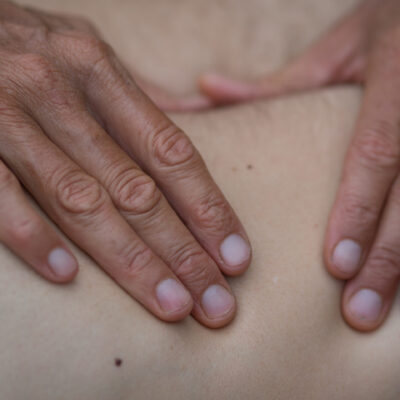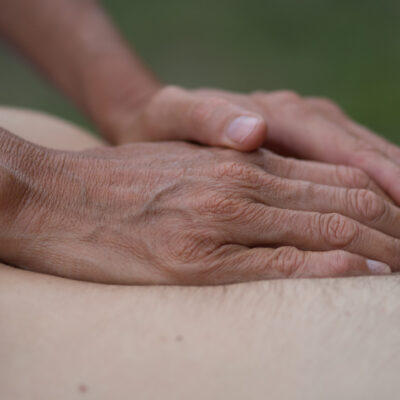

The Art of Hands-On Healing
Manual therapies can offer a holistic approach to healing. By working with the body’s innate intelligence and its natural ability to restore balance and function, my gentle, non-invasive approach encourages the body to heal itself in a harmonious and integrated way. Techniques like Visceral Osteopathy, Neural and Vascular Manipulations and Craniosacral Therapy work together to relieve pain, support long term health and promote overall well-being.
My Approach
Healing Step-by-Step
My Philosophy
I support patients to overcome physical, emotional and spiritual challenges and to help them to rediscover their health with an intuitive approach.
My Intent
I customize each session to meet the individual needs and goals of the patient, and initiate significant and long-lasting healing effects which will help the patient to increase their performance and stay physically and energetically balanced.
My Focus
I mindfully listen to what the patient’s body has to tell and to find the best possible therapeutic approach to release tension, restrictions and imbalances which can develop from traumas, injuries and dysfunctions.
My Goal
I create space for change and healing and to discover the resources for future physical and spiritual improvements



Visceral Osteopathy
How Visceral Osteopathy Can Improve Your Overall Health
Visceral Osteopathy or Visceral Manipulation is a gentle manual therapy that aids your body’s ability to release restrictions and unhealthy compensations that cause pain and dysfunction. “Visceral” relates to the internal organs of the body, such as the liver, the kidneys and the intestines etc. Restrictions in these visceral organs can potentially influence structural and physiological dysfunctions. A trained therapist feels for decreased or altered motions within the viscera as well as restricted patterns throughout the body, and then applies techniques to help those areas to regain their vitality and free range of motion.
Meet Jean Pierre Barral
Please meet Jean Pierre Barral – an amazing French Osteopath and innovative healthcare professional. He developed “Visceral Manipulation” a gentle and precise form of manual therapy focusing on the internal organs and their fascial environment. Visceral Manipulation recreates, harmonizes, and increases proprioceptive communication. I am happy to be a student of the Barral Institute and to be able to benefit from Jean Pierre’s knowledge and to deepen my skills with every class I take.
"Respect the tissue."
Jean-Pierre Barral
Craniosacral Therapy
Restoring Balance Through Fluid Dynamics
Craniosacral Therapy (CST) is an important part of the osteopathic medicine. “Cranio” means skull and “sacral” refers to the sacrum, our sitting bone. It is by definition a system of gentle touch designed to enhance the functioning of the membranes, tissues, fluids, and bones surrounding or associated with the brain and spinal cord. It follows the same basic principles as osteopathy and also makes the patient as a whole the center of attention.
1. The body functions as a unit.
All systems of the body work together and are interrelated. If one system or a part of the body is compromised, the whole body is not able to live in its healthiest potential.
2. The structure of the body governs the body’s function.
The body will not function optimally if a structure is compromised. Mechanical problems often follow physiological changes that have affected different tissues.
3. The flow of the fluids in the body must be maintained and preserved.
If an artery or vein is restricted, the tissue will not function to its full capacity.
4. The body has the inherent ability to heal itself.
An Osteopathic Manual Practitioner works to find the restriction, free it up with the help of the body, and allow the body to live to its full potential/optimal health.
The American Osteopath William G. Sutherland discovered in the 1920s that the cerebrospinal fluid - the liquor that protects, nourishes and surrounds our brain and central nervous system - has a rhythmic and fluctuating motion. The free motion of this fluid is crucial for our health and is only guaranteed when the meninges, the 22 bones of the skull and the sacrum move without restrictions. Birth traumas and traumatic experiences later in life, as well as accidents, stress or general tension can restrict the free flow of the cerebrospinal liquor, potentially leading to serious health issues over time. A precise knowledge of human anatomy is essential to identify the parts of the body, where restrictions inhibit the free flow of the cerebrospinal fluid.
“If you understand the mechanism, the treatment is simple.”
W.G. Sutherland
Classical Homeopathy
A Deep Dive into Individualization
Homeopathy, or Homeopathic Medicine, is the practice of medicine that embraces a holistic, natural approach to the treatment of the sick. Homeopathy is holistic because it treats the person as a whole, rather than focusing on a diseased part or a labeled sickness.
The word Homeopathy, which comes from the Greek, through Latin into English, literally means “like disease”. This means that the medicine given is like the disease that the person is expressing, in his totality, not a specific disease category or medical diagnosis.
The guiding principle of Homeopathy is stated as “let likes cure likes,” similia similibus curentur. While the concept of “like curing like” dates back to the Greek Father of Medicine, Hippocrates (460-377 B.C.), it was German physician Dr. C. F. Samuel Hahnemann (1755-1843) who first codified this principle into a system of medicine. Starting with experiments (called “provings”) on himself, Dr. Hahnemann administered medicinal substances to healthy volunteers (called “provers”). Symptoms that developed in the provers while taking a specific substance gave the homeopathic “picture” of, and indications for, that remedy. Over the years, by means of provings, toxicological data, and clinical experience, the homeopathic drug pictures of over 2000 substances have been derived.
In the practice of Homeopathic Medicine, a detailed, comprehensive interview of the patient, called the homeopathic case-taking, is undertaken to reveal the physical, psychological and emotional characteristics and complaints of that individual. The homeopathic practitioner then finds the homeopathic remedy whose materia medica (drug picture) is the most similar to that of the patient’s characteristic totality. That homeopathic prescription (the similimum) is given to the patient to stimulate his/her being to heal: likes cures likes.
"Good health is not a state, but a search for equilibrium."
Jacques Descotes
Therapeutic Massage
Promoting Relaxation and Wellbeing
The purpose of massage therapy is to undo the stress and damage that the muscles endure when they get overworked. When muscles become stressed, they tend to block oxygen and nutrients, which leads to inflammation and toxins in the muscle tissue. Massage techniques increases blood circulation and bring more oxygen and nutrients into the muscle. Massage stimulates the parasympathetic nervous system which promotes positive body awareness and relaxation.
I like to integrate massage as an additional tool to reduce pain, tightness, stiffness and spasms. By improving the muscle tone and balance with specific massage I have another tool to reduce the physical stress placed on bones and joints. Myofascial Release, Deep Tissue Massage, Proprioceptive Neural Facilitation and Muscle Energy Techniques can be an important part of a treatment plan in order to help increase joint mobility and to release restrictions in the fascia of the muscular system.
Ready to Grow? Ask a Question or Book a Session.
I'm here to answer questions, address your specific needs, and help you on your healing journey.







